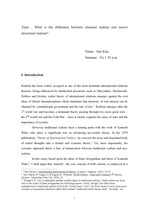

BRONZE
BRONZE 등급의 판매자 자료
Classical and neo realism in International Relations Theories
본 Essay는 제가 런던정경대(London School of Economics & Political Science)의 국제관계학 석사 과정 시 작성했던 Essay이며, 70점 이상을 받았던 Essay 입니다. (일반적으로 70점 이상은 전체 학생의 5~10%에게 부여)
Essay Question 은 What is the difference between classical realism and neo(or structural) realism? 이며 편의상 Classical and Neo realism in International Relations Theories는 제목으로 바꿔서 올립니다.
참고로 제 Essay 및 논문을 표절의 형식으로 사용하시지 않길 요청드리며, idea generation 의 참고자료로 사용하시길 부탁드립니다
8 페이지
최초등록일 2009.05.21
최종저작일
2004.05

-
미리보기
소개
본 Essay는 제가 런던정경대(London School of Economics & Political Science)의 국제관계학 석사 과정 시 작성했던 Essay이며, 70점 이상을 받았던 Essay 입니다. (일반적으로 70점 이상은 전체 학생의 5~10%에게 부여)
Essay Question 은 What is the difference between classical realism and neo(or structural) realism? 이며 편의상 Classical and Neo realism in International Relations Theories는 제목으로 바꿔서 올립니다.
참고로 제 Essay 및 논문을 표절의 형식으로 사용하시지 않길 요청드리며, idea generation 의 참고자료로 사용하시길 부탁드립니다목차
I. Introduction
II. Role of the Concept of Anarchy in Evaluating Each Theory
III. Level of Analysis
IV. Power and the Balance of Power
V. View on Unit level, Ideological and Moral Factors
VI. Conclusion본문내용
I have, so far, referred to the differences between traditional realism and neo-realism based on the works of Hans Morgenthau and Kenneth Waltz. Firstly, while traditional realism highlights the concept of the state as a unitary and rational actor, neo-realism, adding to traditional realist core concept of state, regards the international political structure as the most significant determinant in the realm of international politics.
Secondly, for traditional realism, ideological and moral factors are regarded as important not in the sense that they are driving factors in shaping world politics but in the sense that they are important sources of national power. By contrast, neo-realism takes systemic approach and argues that the sub-national level seems to be of little importance since states’ behaviour is more likely to be determined by structural constraints rather than actions of units.
Thirdly, whereas traditional realism thinks of power as an ultimate aim, neo-realism sees it as a useful means for survival or domination in the distribution of power.
All things considered, the basic assumption which distinguishes neo-realism from traditional realism is thought to be its emphasis upon the structural constraints upon states’ behaviour, since the differences in the concept of power, the role of unit-level, ideological factors and moral principles seem to stem from the neo-realist view of the importance of system.참고자료
· Brown, Chris. Understanding International Relations, 2nd edition, London : Palgrave, 2001.
· Evans, Graham. & Newnham, Jefferey. The Penguin Dictionary of International Relations, London : Penguin Books, 1998.
· Hobbes, Thomas. Leviathan, edited by Richard Tucks, Cambridge : Cambridge University Press, 1996.
· Jervis, Robert. “Realism, Game Theory, and Cooperation”, World Politics 40, no. 3 (1988).
· Kegley Jr, Charles. W. & Wittkopf, Eugene. R. World Politics : Trend and Formation, 4th edition, Boston : Macmillan Press Ltd, 1999.
· Morgenthau, Hans. Politics among Nations : The Struggle for Power and Peace, Brief edition, USA : McGraw-Hill, 1993.
· Waltz, Kenneth. Man, the State and War : A Theoretical Analysis, New York : Columbia University Press : 2001.
· Waltz, Kenneth. Theory of International Politics, New York : Random House, 1979.
· Waltz, Kenneth. “Realist Thought and Neo-realist Theory” in Controversies in International Theory : Realism and the Neoliberal Challenge, New York : St.Martin’s Press, 1995.태그
-
자료후기
-
자주묻는질문의 답변을 확인해 주세요

꼭 알아주세요
-
자료의 정보 및 내용의 진실성에 대하여 해피캠퍼스는 보증하지 않으며, 해당 정보 및 게시물 저작권과 기타 법적 책임은 자료 등록자에게 있습니다.
자료 및 게시물 내용의 불법적 이용, 무단 전재∙배포는 금지되어 있습니다.
저작권침해, 명예훼손 등 분쟁 요소 발견 시 고객센터의 저작권침해 신고센터를 이용해 주시기 바랍니다. -
해피캠퍼스는 구매자와 판매자 모두가 만족하는 서비스가 되도록 노력하고 있으며, 아래의 4가지 자료환불 조건을 꼭 확인해주시기 바랍니다.
파일오류 중복자료 저작권 없음 설명과 실제 내용 불일치 파일의 다운로드가 제대로 되지 않거나 파일형식에 맞는 프로그램으로 정상 작동하지 않는 경우 다른 자료와 70% 이상 내용이 일치하는 경우 (중복임을 확인할 수 있는 근거 필요함) 인터넷의 다른 사이트, 연구기관, 학교, 서적 등의 자료를 도용한 경우 자료의 설명과 실제 자료의 내용이 일치하지 않는 경우
함께 구매한 자료도 확인해 보세요!
-
국제관계학 시험 레포트 4페이지
Question 1: (1) How does the international political system differ from the domestic political system? This question is pretty easy because we already covered about this topic on the very first .. -
국제관계학 기말고사 레포트 4페이지
A) What are the characteristics of power? : As far as I remember, the week after mid-term exam, we covered about ‘power’ in the class. I still remember the sentence, "International politics is a st.. -
[외교] US vs IRaq 6페이지
International war, as part of International Relations, can be defined as conflict among states, and it has existed since human beings appeared on the earth. Whether this conflict or diplomacy among s.. -
[국제정치학]현실주의와 신현실주의 5페이지
신현실주의는 자유주의의 복합적 상호의존론과 글로벌리즘의 세계체제론을 반박하면서 대두 되었다. 신현실주의 이론가들은 앞의 두 이론이 국제정치적 현실에 대해 소홀한 점을 지적하며 그에 적절한 설명을 하려고 노력하였다. 신현실주의를 설명하는 방식은 크게 두 가지로 나뉘는데 첫 번째는 Gilpin과 Lake와 같은 이론가들의 설명방식으로 국제경제현상에 대한 지대한.. -
[국제정치] 신현실주의 9페이지
1) 신현실주의의 등장배경 - 1970년대 말과 1980년대 초의 이란 미 대사관 점거, 소련의 아프가니스탄 침공, 동서간의 대립, 방위 예산의 증가, 핵무기의 현대화 등으로 현실주의 이론의 적실성 부각 ->신현실주의 부상 ① 국가는 여전히 자율적, 초국가적 행위자와의 관계에서 국가는 여전히 권력과 사회의 보편적 이익과 관련된 목적을 자율적으로 ..
문서 초안을 생성해주는 EasyAI
